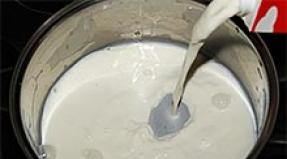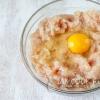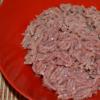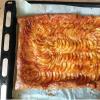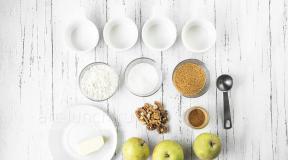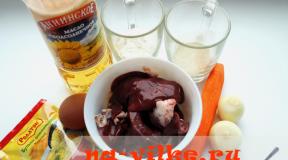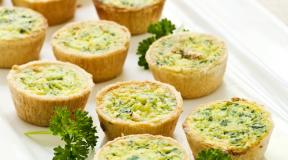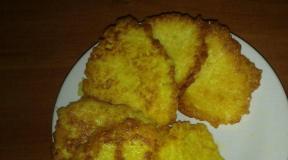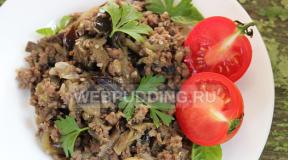Placindas with potatoes. Step-by-step recipe for preparing Moldovan placindas with photos Recipe for dough for placinda with potatoes
Every nation has its own national dishes. Even such a common product as a pie, everyone approaches it differently. Well, the names of the pies are different accordingly. For example, in Moldova, housewives cook placintas very well. These are large round pies with all kinds of fillings: potatoes, cottage cheese, apples, pumpkin, meat. They are fried in oil and baked in the oven. And the dough is made both with yeast and unleavened. Placindas made with kefir are especially tasty. These fluffy filled flatbreads are easy to prepare, which is why they are very popular.
Today I want to invite you to prepare placintas with potatoes and meat using kefir dough.
![]()
For the test:
- 450-500 grams of flour;
- 400 grams of kefir;
- 10 grams of salt;
- 5 grams of sugar;
- 5 grams of soda;
- 20 grams of vegetable oil in the dough;
- vegetable oil for frying.
For fillings:
- 6 potatoes;
- 2 large onions;
- 500 grams of minced meat;
- salt;
- ground black pepper;
- 30 grams of vegetable oil.
First prepare the dough. To do this, pour flour mixed with baking soda into a bowl and make a well. Put salt and sugar there. Pour kefir into the hole.

Stir with a spoon, and when the dough becomes thick, put the spoon aside and knead the dough with your hand.

It should turn out soft. Pour oil into your palm and lightly knead the dough with it.

Let the dough rest, covered, for about one hour.

In the meantime, prepare the fillings for the placinda.
Cut the onion into cubes and fry it in oil.
Boil the potatoes in a small amount of water. Make a puree. Divide it into two unequal parts.

Place half the onion in the bowl with most of the mashed potatoes. Add spices and stir.

And add minced meat, salt, pepper to the remaining onion and mix.

Bring to readiness and remove from heat.
Grease the table and hands with oil. If you use flour instead of butter, then when frying the flour will burn, and after the second or third platinum the butter will become dark, and the products will acquire a burnt taste.

Remove the dough from the bowl and divide into 7 or 8 pieces.
Roll out each piece with a rolling pin, also greased with oil, into a thin flat cake the size of a plate.

Place the filling in the middle of the juice. Make ray-shaped cuts on the dough, slightly short of the filling.

Fold the dough towards the middle, enclosing the filling. Flatten the placinda slightly. Do the same with the meat filling.

Pour a tablespoon of oil into the frying pan, heat it and place the placinda seam side down. Turn the heat to less than medium and fry the placintas with the lid on.

Once one side is browned, flip the tortilla over to the other side. Add a little oil before frying the next placinta.

Stack the finished placintas one on top of the other so that they do not cool down for a long time.

When it comes to the small country of Moldova, one immediately thinks of vineyards, an abundance of vegetables and fruits, pastures with sheep and poultry farms.
Moldova is famous throughout the world for its winemaking, sheep and poultry farming. All these riches, donated by nature, are used in national cuisine. Interesting and unique, tasty and satisfying Moldovan dishes are becoming increasingly in demand in different parts of the globe.
Mamalyga and mititei, zama and chorba, and of course the famous Moldovan placinda, which we will talk about in more detail. This simple and tasty dish is prepared from ordinary unleavened dough, added with various fillings and fried in oil.
In winter, placintas are stuffed with potatoes or pumpkin, mushrooms or cabbage. And with the onset of spring, when a lot of fresh herbs appear, feta cheese or cottage cheese with finely chopped dill, parsley, and cilantro are used as a filling. Placindas are prepared in Moldova all year round; housewives serve this delicacy to their households and guests almost every week.
Dough for Moldovan placinda
The main component of the Moldavian placinda is the dough. And although it is fresh and very simple, still start working with it when there is a good mood in the house, the dough also really loves kind and warm hands.
Ingredients:
- white wheat flour – 400 g,
- salt – ¼ teaspoon,
- warm drinking water – 250 ml,
- vegetable oil – 3 tablespoons.
Preparation:
1. Take a wide and deep bowl. Sift flour into it and sprinkle salt on top.
2. Make a small well in the center of the flour and gradually pour lukewarm water into it. The stream of water should be thin. At the same time, gently knead the dough with your hand or using a spoon. Knead the dough for a long time (15-20 minutes) until it is soft, elastic, and pliable. This is the main secret of stretch dough - long kneading.
3. At the end of the kneading, add vegetable oil, mix everything thoroughly again and let the dough rest. In this case, it is necessary to cover the bowl with a towel or cover it with cling film, otherwise the dough may dry out.
Filling options for Moldavian placinda
While the dough is resting, you should start preparing the filling. Several of the most popular options will be discussed below.
With potato

Ingredients:
- potatoes – 400 g,
- onions – 100 g,
- salt – ½ teaspoon,
- ground black pepper - to your taste,
- fresh parsley and dill - to your taste.
Preparation:
1. Peel and rinse the potatoes thoroughly. Cut it into very small cubes.
2. Peel the onions, rinse and also cut into small cubes.
3. Finely chop fresh parsley and dill.
4. Combine all prepared ingredients, add salt, pepper and mix.
With cabbage

Ingredients:
- white cabbage – 400 g,
- large onions - 2 pieces,
- salt and ground black pepper - to your taste,
- vegetable oil – 2 tablespoons.
Preparation:
1. Wash the cabbage, dry it slightly and chop it very thinly.
2. Peel, wash and cut the onions into thin half rings.
3. Combine cabbage with onion, salt and pepper, add vegetable oil and stir.
With pumpkin

Ingredients:
- pumpkin pulp – 500 g,
- salt - a pinch,
- sugar - to your taste.
Preparation:
1. Rinse the pumpkin pulp, dry and grate on a coarse grater. Add a pinch of salt, stir and let stand for about half an hour (during this time the pumpkin will release juice).
2. Squeeze out the pumpkin juice that appears. Now place the pumpkin filling in the middle of the platinum and sprinkle sugar on top (those with a sweet tooth can add more sugar; those watching calories can sprinkle the pumpkin with just a little sugar).
With cottage cheese and herbs

Ingredients:
- cottage cheese – 500 g,
- green onions – 100-150 g,
- salt – 1 teaspoon,
- fresh dill – 50-70 g,
- chicken eggs - 2 pieces.
Preparation:
1. Wash, dry and very finely chop fresh dill and green onions.
2. In a deep bowl, mix cottage cheese, salt, chopped herbs and raw chicken eggs.
Preparation and baking of placinda
1. Sprinkle the table with flour, lay out the rested dough and divide it into equal pieces (depending on the size of the baked goods you want to get in the end, and also depending on the size of the frying pan in which you will bake the placindas). Roll each piece of dough into a ball.
2. Take one ball and roll it out very thin (the dough is also called stretch dough, because when rolling it stretches as far as possible). First, roll out the dough using a rolling pin, then continue stretching the dough with both hands. If it suddenly breaks, carefully seal it and level the area where it broke.

3. Place the filling in the middle of the rolled out dough. At equal intervals, make seven cuts in the dough from the place where the filling is located to the very edge. It turns out something similar to a flower with separate petals. 
4. Now wrap the placinda, placing each petal in turn towards the center on the filling. When all the cut pieces of dough are placed on the center with the filling, carefully flatten the resulting placinda with your hand and then gently roll it out with a rolling pin as thin as possible. 
5. Proceed in the same way with all prepared dough balls. Heat the vegetable oil in a frying pan and fry each placinda on both sides until an appetizing golden brown crust forms. Frying will take approximately 5-7 minutes on each side; this should be done over low heat and under the lid (so that the filling has time to prepare). Coat the finished baked goods with vegetable or melted butter and place in a stack. 
Adviсe:
- To prevent the dough from getting chapped during rest, you can grease it with a thin layer of vegetable oil and cover it with a warm bowl on top. Heating a bowl is not difficult at all: pour boiling water into it, when it is hot, drain the water, wipe dry and cover the bowl with the dough;— to prepare stretch dough, it is advisable to use flour with a high gluten content;
- so that the dough petals fit better on top of each other and stick together when wrapped, you can lightly moisten them with water;
- do not put eggs in the dough for the placinda, it will turn out inelastic and will tear when stretched;
- after you roll out the dough with a rolling pin, grease it lightly with vegetable oil and leave for about five minutes. Then stretch it with your hands, it will be more pliable and viscous;
- if you are not against cracklings, then you can finely chop them and add them to the potato filling, due to which the cracklings will turn out more juicy;
— if desired, you can add finely chopped boiled eggs to the cabbage filling;
— in the curd filling you can combine half and half cottage cheese and feta cheese.
1. Before preparing the potato placinda, sift the flour. Combine it with salt. Add water and knead the dough for a few minutes until it becomes smooth and stiff. Form into a ball. Cover with a towel. Leave the dough to rest. Take out the dough. Divide into 6 or 8 balls. Cover with a towel and set aside for 10 minutes.

2. Prepare the filling. To do this, peel the potatoes. Cut into small pieces. Peel and finely chop the onion. Cut the washed greens. Combine everything in one plate, add salt.

3. Roll out each ball of dough thinner. Place the filling in the middle of the layer, about 2 tablespoons each. Now roll up the dough starting from the corners. For better gluing, lightly moisten the dough.

4. Heat a frying pan with vegetable oil. Place the placinda in the pan, seams down. Cover with a lid. Cook over low heat. When one side is fried, turn it over to the other. Cover with a lid and continue to fry over low heat. This way the filling is fully prepared. Serve the placinda warm. Bon appetit.
Almost all peoples of the world have their own culinary customs and national dishes. Today I propose to get acquainted with Moldavian cuisine, and for this we will prepare Moldavian flatbreads with potato filling, called placintas. Moldavian placindas are a very tasty and colorful dish, similar to our fried pies. In addition to potatoes, the filling includes cottage cheese and herbs,... There are also several dough options - yeast, yeast-free with water or kefir. Moldavian housewives fry placintas in a frying pan, although baking in the oven is also acceptable.
Hot Moldavian flatbread has a thin crispy crust, and if the placintas sit, they become very soft.
Ingredients:
for test:
- flour - 250 g
- water - 125 g
- egg - 1 pc.
- vegetable oil - 2 tbsp. l.
- a pinch of salt
For filling:
- medium potatoes – 3-4 pcs.
- canned fish – 1 can (optional)
- onions or green onions
- salt and black pepper - to taste
- number of servings – 4 pcs
How to prepare placintas with potatoes:
First of all, to prepare placintas in water, knead the unleavened dough. Pour the flour into a mound and make a well in the center. Drive a chicken egg into this hole. Dissolve salt in warm water, mix and carefully pour into flour. We also add vegetable oil. Knead a fairly stiff dough that has a smooth and uniform structure. Cover the dough with a napkin and let rest for about 30 minutes.
In the meantime, let's make the filling. Potato tubers need to be peeled, washed and grated on a coarse grater. Drain the excess oil from the canned fish and then mash with a fork. The greens should be washed and finely chopped. Mix these ingredients, pepper and salt.
Lubricate the working surface with vegetable oil. Take the dough and divide it into four equal pieces. Roll each piece into a ball and, using a rolling pin, roll it out very thinly. The thickness of the resulting pancake should not exceed 3-5 mm. Place the filling in the center. 
We wrap the cake, bending the free edges in a circle, as indicated in the photo.


Fry separately in a frying pan using refined, odorless sunflower oil. Place the flatbread on the pan with the seam side, then reduce the heat and continue frying with the lid closed. Then carefully flip the tortilla over to the other side. The second side will take a few more minutes to fry. Moldavian placintas with potatoes will be ready when a golden crust forms on their surface.

Place the potato pancakes on napkins so that they absorb the oil from their surface. After this, transfer to a plate and wait for it to cool slightly.
You can try! Bon appetit!!!

Sincerely, .
Description
– a traditional dish of Moldavian cuisine. It is prepared in the form of a pie, more like a flatbread. It can be round or square.
The filling for placintas does not always have to be potato. There are several recipes for preparing this dish with fillings from feta cheese, cottage cheese, cabbage, meat, pumpkin or apples. Sometimes several types of filling are combined, but the taste can turn out to be very specific, so experiment without fanaticism.
Classic placintas are rightfully considered the hallmark of Moldova. In this country, there is still a tradition of baking these wonderful pies on Sundays and treating guests to them, accompanied by wine. Moreover, an interesting fact is that each housewife prepares this dish in her own way, using special secrets passed down from generation to generation.
Such a treat as placintas is prepared as a dessert, as a snack, and as a main dish. During the cooking process, the dough is pinched in a rather interesting way, thanks to which the finished pies have a peculiar pattern on the front side.
To prepare Moldovan placintas with potatoes at home, you won’t need much time. Therefore, this dish is ideal if your guests show up unannounced. All you need is the necessary list of products that are used in cooking, and our recipe with step-by-step photos. And we guarantee you that your potato dumplings will conquer even the most notorious gourmet.
Ingredients
-
(550 g) -
(400 g) -
(10 g) -
(1 tsp) -
(100 g) -
(100 ml)
Cooking steps
First, choose a comfortable wide bowl, then sift the flour into it, make a small hole in the center and pour in water. Add salt and start kneading. You need to knead for several minutes until the mass becomes homogeneous. After this, you need to roll the dough into a ball, cover it with a towel and let it sit for about 10 minutes.

After the above time has passed, take the dough and divide it into 6-8 equal parts, each of which, in turn, turn into a ball. Cover the resulting balls with a towel again and let them stand for 10 minutes.

While the dough is resting, we can make the filling. Take raw potatoes, peel them and cut them into cubes as small as possible.

In the same bowl where you cut the potatoes, chop the onion. Also very small.

Add finely chopped herbs, salt and mix the filling thoroughly.

Now take the dough, roll each of the balls one by one into a thin cake. Then place 1-2 tablespoons of filling in the center of the cake and begin to wrap the dough as shown in the picture. If it doesn't stick well, you can moisten the dough with water.

Pour oil into a frying pan and preheat it over low heat. Next, you can place the flatbreads on it one at a time, seams down. Cover with a lid and cook for about 7 minutes. Watch the placinta when it is covered with a golden crust - one side is ready.

Turn the patty over and cook the other side for the same amount of time as the first. Cover with a lid too.

When the potato dumplings are ready, place them on a plate and you can serve them.

Bon appetit!
